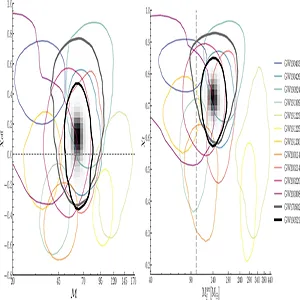
Strong evidence points to the existence of a new category of black holes
Astronomers believe they have finally confirmed the existence of a group of black holes that are too hefty to be born from normal stars, yet too slim to anchor galaxies – intermediate-mass black holes.
According to Vanderbilt University astrophysicist Krystal Ruiz-Rocha, these bodies have masses of 100 to 300 times that of the Sun, and emerged in data from the third observing run of the gravitational‑wave detectors LIGO and Virgo.
Most known black holes sit either below 50 solar masses or soar into the millions, leaving a puzzling middle zone.
Finding occupants of this zone matters because their masses preserve clues about how the first heavy stars lived and died.
Mergers of collapsing giants
LIGO and Virgo register ripples in spacetime that last less than a half‑second, yet from that faint murmur scientists can compute the masses and spins of the colliding objects.
During the 2019–2020 run, the network logged eleven mergers whose combined detector‑frame masses exceeded 100 Suns, hinting at a fresh category of “lite” intermediate objects.
“Black holes are the ultimate cosmic fossils,” said Karan Jani, lead scientist of Vanderbilt’s Lunar Labs Initiative.
His team used a Bayesian code named RIFT to test each event with three waveform families and confidently identified five mergers that left behind remnants of between 110 and 350 solar masses.
Identifying intermediate black holes
Intermediate-mass black holes are hard to identify because their signals fall into the low-frequency range, where ground-based detectors struggle with noise.
That makes it difficult to separate genuine cosmic events from background static, especially for faint or distant mergers.
To overcome this, the researchers used three different waveform models to compare the shape of the observed gravitational waves.

The experts also applied a Bayesian inference tool to estimate the black holes’ masses and spins with greater precision, even when the signals were weak or short.
Repeated mergers in dense clusters
Stellar theory predicts that a pair‑instability supernova blasts apart stars whose cores grow too hot, forbidding black holes between roughly 60 and 120 solar masses.
Yet at least one pre‑merger object in the new sample lands inside that gap, and two more perch above it – supporting the idea that repeated mergers in dense clusters can sidestep the supernova ceiling.
Hierarchical smash‑ups let smaller black holes build larger ones inside young star clusters, where escape speeds are high and fresh companions are plentiful.
Such stacking predicts spins that sometimes point opposite the orbital motion. This is a trait seen in several of the lite candidates – strengthening the case for a dynamical origin.
Future antennas on a celestial stage
Space‑based detectors will catch the same binaries years before they collide on Earth, tracing their slow inspiral and mapping their birthplace.
NASA and ESA’s Laser Interferometer Space Antenna (LISA) is slated for launch in the mid‑2030s and will measure low‑frequency waves that are impossible to hear from the ground.
“Access to lower frequencies from the lunar surface could allow us to identify the environments these black holes live in,” noted post‑doctoral fellow Anjali Yelikar, whose group studies detector concepts for the Moon.
Combining Earth, space, and lunar observatories would stretch the observable waveform from minutes to years, and offer a full biography of each merger.
Missing link among black holes
Across the sample, the farthest event traveled roughly 37 billion light‑years to reach us, while the nearest sat a scant 2.5 billion light‑years away.
Five of the mergers have over a 95 percent chance of producing a remnant above the 100‑solar‑mass threshold, making them the heaviest gravitational‑wave sources on record.
Lite intermediate-mass black holes could be the missing link between the well-known populations of stellar and supermassive black holes.
Understanding how these middleweights form and where they live helps astrophysicists refine models for galaxy growth, star cluster dynamics, and the history of matter in the universe.

Studying intermediate-mass black holes
Some theories suggest that intermediate black holes may grow into the supermassive black holes that sit at galactic centers. Others may be relics from the first generation of stars, and may offer a glimpse into a time before the first galaxies formed.
“We hope this research strengthens the case for intermediate‑mass black holes as the most exciting source across the detector network,” said Ruiz‑Rocha.
With every new detection, astronomers refine their census of black holes and inch closer to uncovering the first generation of stars that seeded today’s galaxies.
The study is published in The Astrophysical Journal Letters.
—–
Like what you read? Subscribe to our newsletter for engaging articles, exclusive content, and the latest updates.
Check us out on EarthSnap, a free app brought to you by Eric Ralls and Earth.com.
—–













